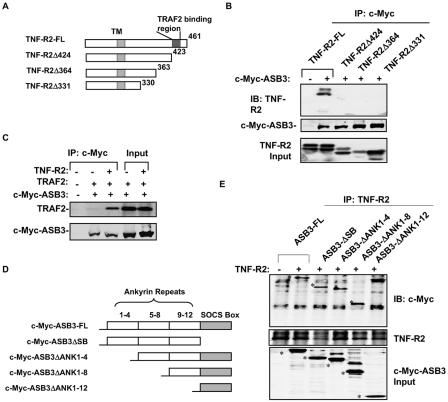FIG. 3.
ANK repeats of ASB3 and the C terminus of TNF-R2 are responsible for their interaction. (A) Schematic illustration of TNF-R2 deletion mutants. TM, transmembrane domain. (B) ASB3 (1 μg) was transfected into 293 cells with full-length (FL) TNF-R2 (1 μg) or a deletion mutant, as indicated. After transfection for 48 h, whole-cell extracts were prepared and immunoprecipitated with anti-c-Myc, followed by anti-TNF-R2 or anti-c-Myc blotting as indicated. TNF-R2 expression levels are shown in the bottom panel. (C) 293 cells were cotransfected with ASB3 (1 μg) and TRAF2 (1 μg), with or without TNF-R2, as indicated. Whole-cell extracts were prepared and immunoprecipitated with anti-c-Myc, followed by Western blot analysis with anti-TRAF2 or anti-c-Myc. (D) Schematic illustration of c-Myc-ASB3 with ANK deletion mutations. (E) 293 cells were cotransfected with full-length ASB3 (1 μg) or an ANK deletion mutant and with TNF-R2 (1 μg) or an empty vector (1 μg). Forty-eight hours after transfection, whole-cell extracts were prepared for immunoprecipitation with anti-TNF-R2, followed by Western blot analysis with anti-c-Myc or anti-TNF-R2. The ASB3 expression input (anti-c-Myc) is shown in the bottom panel. Asterisks mark anti-c-Myc signals.

